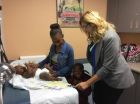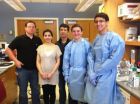(Press-News.org) Well-child visits are the foundation of pediatric primary care in the U.S. Accounting for more than one-third of all outpatient visits for infants and toddlers, the appointments are intended to give doctors the opportunity to identify health, social, developmental and behavioral issues that could have a long-term impact on children's lives.
However, several studies have shown that the current system of well-child care leaves room for improvement. One major concern is that well-child care guidelines issued by the American Academy of Pediatrics call for physicians to provide more services than can realistically be completed within a 15-minute office visit. As a result, many children do not get all of the preventive care services that they need — and the problem is more acute for low-income families, thanks largely due to their greater psychosocial and developmental needs for and greater need for parenting education.
In a year-long study led by Dr. Tumaini Coker, an assistant professor of pediatrics at Mattel Children's Hospital UCLA, researchers developed a new design for preventive health care for children from birth through age 3 from low-income communities. The team partnered with two community pediatric practices and a multi-site community health center in greater Los Angeles.
"The usual way of providing preventive care to young children is just not meeting the needs of the low-income families served by these clinics and practices," said Coker, who also is a researcher with the hospital's UCLA Children's Discovery and Innovation Institute. "Our goal was to create an innovative and reproducible — but locally customizable — approach to deliver comprehensive preventive care that is more family-centered, effective and efficient."
The researchers created two working groups of pediatric clinicians, staff, clinic leadership and parents to design the new models of care. One working group was at South Bay Family Health Care, and another working group combined the efforts of two pediatric practices, the YovanaBruno Pediatric Clinic in Duarte, California, and Wee Care Associates (led by Dr. Toni Johnson-Chavis), in Compton and Norwalk, California.
To design the new models of care, researchers gathered input from two sources. First, they solicited ideas from pediatricians, parents and health plan representatives about topics such as having non-physicians provide routine preventive care and using "alternative visit formats" — meeting with health care providers in alternative locations, meeting in groups as opposed to one-on-one, or getting providers' advice electronically instead of in person, for example. Secondly, the teams surveyed existing literature on alternative providers, locations and formats for well-child care.
Using that input, the clinic working groups developed four possible new models of care that it submitted for review by a panel of experts on preventive care practice redesign. Based on the panel's rankings, the working groups selected two models to implement and test — one for the private practices and the other for the community clinic. The private practices adopted a one-on-one visit format while the community clinic used a group-visit format, but the two models shared several characteristics:
A trained health educator, or "parent coach," at each facility who relieves the physician of some of the more routine services and provides preventive health education and guidance, parenting education, and comprehensive but efficient preventive health services related to development, behavior and family psychosocial concerns.
A considerably longer preventive care visit.
A website that enables parents to customize their child's specific needs prior to their visit.
Scheduled text messages or phone calls enabling the health care team to communicate with parents.
These findings were reported online June 16 in the journal Pediatrics.
The next stage of research is already underway: The team is testing the model selected by the two private practices in those clinical settings, with families randomly chosen to receive the care using either the new delivery model and or the old one. Researchers will compare outcomes for the two groups of children by the end of 2014. The community clinic is currently implementing its selected model, and testing will begin there in July.
"For clinics and practices that provide child preventive health care to families living in low-income communities, the process we used to develop the new models — or the new models themselves — could help them bring innovation to their own practices," Coker said.
INFORMATION:
The study was funded by grants from the National Institutes of Health's National Institute of Child Health and Development and the Health Resources and Service Administration.
The study's other authors were Dr. Paul Chung and Dr. Paul Shekelle of UCLA, Candice Moreno of the University of Illinois College of Medicine and Dr. Mark Schuster of Harvard Medical School. The authors have no financial ties relevant to this article to disclose.
Redesigning the well-child checkup
UCLA study suggests new models for more efficiently delivering preventive care to low-income families
2014-06-16
ELSE PRESS RELEASES FROM THIS DATE:
Many bodies prompt stem cells to change
2014-06-16
HOUSTON – (June 16, 2014) – How does a stem cell decide what path to take? In a way, it's up to the wisdom of the crowd.
The DNA in a pluripotent stem cell is bombarded with waves of proteins whose ebb and flow nudge the cell toward becoming blood, bone, skin or organs. A new theory by scientists at Rice University shows the cell's journey is neither a simple step-by-step process nor all random.
Theoretical biologist Peter Wolynes and postdoctoral fellow Bin Zhang set out to create a mathematical tool to analyze large, realistic gene networks. As a bonus, their open-access ...
Researchers create better methods to detect E. coli
2014-06-16
MANHATTAN, KANSAS — Kansas State University diagnosticians are helping the cattle industry save millions of dollars each year by developing earlier and accurate detection of E. coli.
Lance Noll, master's student in veterinary biomedical science, Greensburg; T.G. Nagaraja, university distinguished professor of diagnostic medicine and pathobiology; and Jianfa Bai, assistant professor in the Kansas State Veterinary Diagnostic Laboratory, are leading a project to improve techniques for detecting pathogenic Shiga toxin-producing E. coli O157:H7. A U.S. Department of Agriculture ...
Getting rid of old mitochondria
2014-06-16
It's broadly assumed that cells degrade and recycle their own old or damaged organelles, but researchers at University of California, San Diego School of Medicine, The Johns Hopkins University School of Medicine and Kennedy Krieger Institute have discovered that some neurons transfer unwanted mitochondria – the tiny power plants inside cells – to supporting glial cells called astrocytes for disposal.
The findings, published in the June 17 online Early Edition of PNAS, suggest some basic biology may need revising, but they also have potential implications for improving ...
Discovery of Earth's northernmost perennial spring
2014-06-16
Boulder, Colo., USA – A Canadian team lead by Stephen Grasby reports the discovery of the highest latitude perennial spring known in the world. This high-volume spring demonstrates that deep groundwater circulation through the cryosphere occurs, and can form gullies in a region of extreme low temperatures and with morphology remarkably similar to those on Mars. The 2009 discovery raises many new questions because it remains uncertain how such a high-volume spring can originate in a polar desert environment.
Grasby and colleagues encountered the northernmost perennial ...
Pathological gambling runs in families
2014-06-16
A study by University of Iowa researchers confirms that pathological gambling runs in families and shows that first-degree relatives of pathological gamblers are eight times more likely to develop this problem in their lifetime than relatives of people without pathological gambling.
"Our work clearly shows that pathological gambling runs in families at a rate higher than for many other behavioral and psychiatric disorders," says Donald W. Black, MD, professor of psychiatry in the UI Carver College of Medicine. "I think clinicians and health care providers should be alerted ...
Low dose of targeted drug might improve cancer-killing virus therapy
2014-06-16
COLUMBUS, Ohio – Giving low doses of a particular targeted agent with a cancer-killing virus might improve the effectiveness of the virus as a treatment for cancer, according to a study led by researchers at The Ohio State University Comprehensive Cancer Center – Arthur G. James Cancer Hospital and Richard J. Solove Research Institute (OSUCCC – James).
Viruses that are designed to kill cancer cells – oncolytic viruses – have shown promise in clinical trials for the treatment of brain cancer and other solid tumors. This cell and animal study suggests that combining low ...
How our brains store recent memories, cell by single cell
2014-06-16
Confirming what neurocomputational theorists have long suspected, researchers at the Dignity Health Barrow Neurological Institute in Phoenix, Ariz. and University of California, San Diego School of Medicine report that the human brain locks down episodic memories in the hippocampus, committing each recollection to a distinct, distributed fraction of individual cells.
The findings, published in the June 16 Early Edition of PNAS, further illuminate the neural basis of human memory and may, ultimately, shed light on new treatments for diseases and conditions that adversely ...
Omega (ω)-3 inhibits blood vessel growth in a model of age-related macular degeneration in vivo
2014-06-16
Boston (June 16, 2014) – Age-related macular degeneration (AMD), which is characterized by choroidal neovascularization (CNV), or blood vessel growth, is the primary cause of blindness in elderly individuals of industrialized countries. The prevalence of the disease is projected to increase 50% by the year 2020. There is an urgent need for new pharmacological interventions for the treatment and prevention of AMD.
Researchers from Massachusetts Eye and Ear/Schepens Eye Research Institute, Harvard Medical School and other institutions have demonstrated for the first time ...
Caterpillars that eat multiple plant species are more susceptible to hungry birds
2014-06-16
Irvine, Calif. — For caterpillars, having a well-rounded diet can be fraught with peril.
UC Irvine and Wesleyan University biologists have learned that caterpillars that feed on one or two plant species are better able to hide from predatory birds than caterpillars that consume a wide variety of plants.
This is probably because the color patterns and hiding behaviors of the caterpillar "specialists" have evolved to allow them to blend into the background flora more effectively than caterpillars that eat many different plant species. Moving among these diverse plant ...
Hunt for extraterrestrial life gets massive methane boost
2014-06-16
A powerful new model to detect life on planets outside of our solar system, more accurately than ever before, has been developed by UCL (University College London) researchers.
The new model focuses on methane, the simplest organic molecule, widely acknowledged to be a sign of potential life.
Researchers from UCL and the University of New South Wales have developed a new spectrum for 'hot' methane which can be used to detect the molecule at temperatures above that of Earth, up to 1,500K/1220°C – something which was not possible before.
To find out what remote planets ...
LAST 30 PRESS RELEASES:
New study highlights link between eviction rates and gun violence
Heatwaves heat up soil but not toxin levels in rice, study finds
Digital modeling reveals where construction carbon emissions really come from
Turning farm waste into water filters
New study shows how the spleen helps the immune system accept a transplant
New Mayo Clinic study advances personalized prostate cancer education with an EHR-integrated AI agent
Researchers identify novel therapeutic target to improve recovery after nerve injury
Microbes in breast milk help populate infant gut microbiomes
Reprogramming immunity to rewrite the story of Type 1 diabetes
New tool narrows the search for ideal material structures
Artificial saliva containing sugarcane protein helps protect the teeth of patients with head and neck cancer
Understanding the role of linear ubiquitination in T-tubule biogenesis
Researchers identify urban atmosphere as primary reservoir of microplastics
World’s oldest arrow poison – 60,000-year-old traces reveal early advanced hunting techniques
Bristol scientists discover early sponges were soft
New study uncovers how rice viruses manipulate plant defenses to protect insect vectors
NSF–DOE Vera C. Rubin Observatory spots record-breaking asteroid in pre-survey observations
Ribosomal engineering creates “super-probiotic” bacteria
This self-powered eye tracker harnesses energy from blinking and is as comfortable as everyday glasses
Adverse prenatal exposures linked to higher rates of mental health issues, brain changes in adolescents
Restoring mitochondria shows promise for treating chronic nerve pain
Nature study identifies a molecular switch that controls transitions between single-celled and multicellular forms
USU chemists' CRISPR discovery could lead to single diagnostic test for COVID, flu, RSV
Early hominins from Morocco reveal an African lineage near the root of Homo sapiens
Small chimps, big risks: What chimps show us about our own behavior
We finally know how the most common types of planets are created
Thirty-year risk of cardiovascular disease among healthy women according to clinical thresholds of lipoprotein(a)
Yoga for opioid withdrawal and autonomic regulation
Gene therapy ‘switch’ may offer non-addictive pain relief
Study shows your genes determine how fast your DNA mutates with age
[Press-News.org] Redesigning the well-child checkupUCLA study suggests new models for more efficiently delivering preventive care to low-income families








